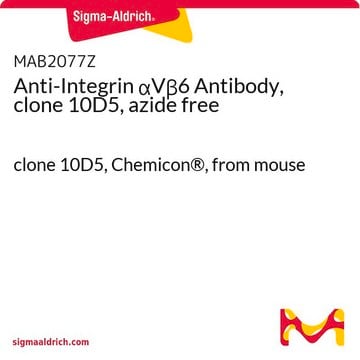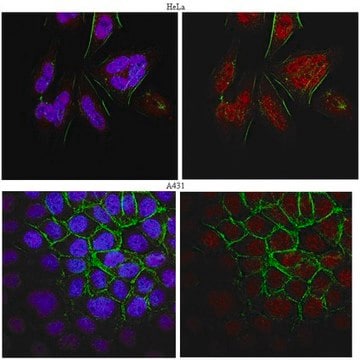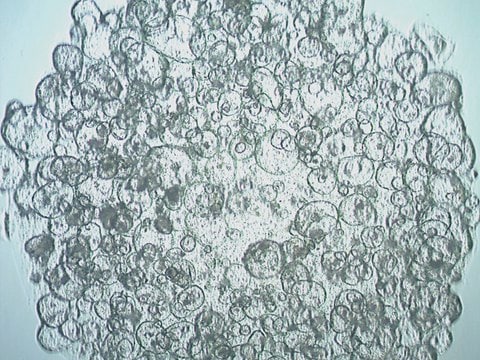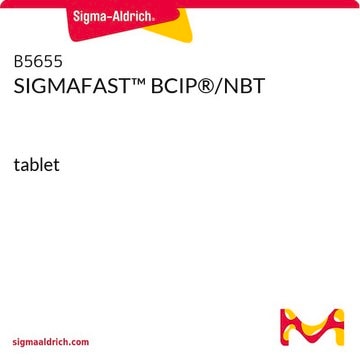AB1922
Anti-Integrin β4 Antibody
serum, Chemicon®
Sinonimo/i:
CD104
Scegli un formato
Scegli un formato
About This Item
Prodotti consigliati
Origine biologica
rabbit
Livello qualitativo
Forma dell’anticorpo
serum
Tipo di anticorpo
primary antibodies
Clone
polyclonal
Reattività contro le specie
human, mouse, rat
Produttore/marchio commerciale
Chemicon®
tecniche
immunohistochemistry: suitable
immunoprecipitation (IP): suitable
N° accesso NCBI
N° accesso UniProt
Condizioni di spedizione
wet ice
modifica post-traduzionali bersaglio
unmodified
Informazioni sul gene
human ... ITGB4(3691)
mouse ... Itgb4(192897)
rat ... Itgb4(25724)
Specificità
Immunogeno
Applicazioni
Immunohistochemistry: 5 μg/mL. See protocol below.
Optimal working dilutions must be determined by the end user.
Suggested Protocol for Immunohistochemical:
1. Fix cryostat sections with a 1:1 chloroform-acetone mixture for 10 minutes at room temperature.
2. Air Dry.
3. Wash with 2 mL of 1x PBS.
4. Add 200 μL of first antibody (5 μg/mL) to each slide. Incubate for 1 hour at room temperature in a humidity chamber.
5. Wash with 5 mL of 1x PBS.
6. Add appropriately diluted anti-rabbit secondary antibody conjugate and incubate for 1 hour in a humidity chamber
7. Wash with 5 mL of 1x PBS.
8. Add 200 μL of development solution (containing DAB or other substrate depending on the secondary antibody) and incubate at room temperature for the necessary time to develop the dark color. Follow the reaction with a microscope, to establish the correct color intensity.
9. Block the reaction by washing with 2 mL of 1x PBS.
10. Counterstain with hematoxylin as desired.
Note legali
Non trovi il prodotto giusto?
Prova il nostro Motore di ricerca dei prodotti.
Codice della classe di stoccaggio
10 - Combustible liquids
Classe di pericolosità dell'acqua (WGK)
WGK 1
Certificati d'analisi (COA)
Cerca il Certificati d'analisi (COA) digitando il numero di lotto/batch corrispondente. I numeri di lotto o di batch sono stampati sull'etichetta dei prodotti dopo la parola ‘Lotto’ o ‘Batch’.
Possiedi già questo prodotto?
I documenti relativi ai prodotti acquistati recentemente sono disponibili nell’Archivio dei documenti.
Active Filters
Il team dei nostri ricercatori vanta grande esperienza in tutte le aree della ricerca quali Life Science, scienza dei materiali, sintesi chimica, cromatografia, discipline analitiche, ecc..
Contatta l'Assistenza Tecnica.








